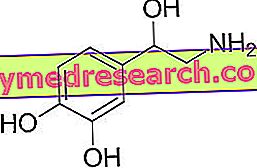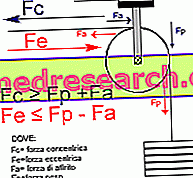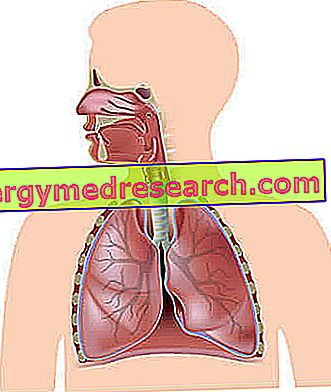
What is Mycamine?
Mycamine is a powder to be dissolved to prepare a solution for infusion (drip into a vein). Contains the active ingredient micafungin.
What is Mycamine used for?
Mycamine is used in infants, children and adults:
- to treat invasive candidiasis (a type of fungal infection caused by a yeast-like fungus called Candida ). The term "invasive" indicates that the fungus has spread to tissues and blood vessels;
- to prevent Candida infection in patients about to undergo bone marrow transplantation (to treat bone marrow or blood problems or some types of cancer) or that are expected to have neutropenia (ie low number of neutrophils, a type of white blood cells) for 10 or more days.
Mycamine is also used to treat esophageal candidiasis in patients over 16 years of age suitable for intravenous therapy.
Mycamine should only be used if other antifungal drugs are unsuitable, as it has been shown that micafungin increases the risk of liver tumors in the rat.
The medicine can only be obtained with a prescription.
How is Mycamine used?
Treatment with Mycamine should be started by a doctor experienced in managing fungal infections and having paid attention to official / national guidelines on the use of antifungal drugs.
Mycamine is given once a day by intravenous infusion lasting about 1 hour. The dose depends on the indication for which the drug is used, the patient's weight and the response to treatment.
Patients treated for invasive candidiasis Mycamine should be administered for at least two weeks and then for a week after the disappearance of the symptoms and traces of the fungus from the blood.
Patients being treated for esophageal candidiasis should continue administration of Mycamine for at least one week after the symptoms have disappeared.
If Mycamine is used to prevent Candida infection, treatment should continue for a week after the normalization of blood counts.
How does Mycamine work?
The active ingredient in Mycamine, micafungin, is an antifungal drug belonging to the "echinocandin" group. It works by interfering with the production of a component of the fungal cell wall called 1, 3-β-D-glucan, which is necessary for the fungus to continue to live and grow. Fungal cells treated with Mycamine have incomplete or defective cell walls, which makes them fragile and unable to grow. The list of fungi against which Mycamine is active is contained in the summary of product characteristics (also part of the EPAR).
How has Mycamine been studied?
The effects of Mycamine were first tested in experimental models before being studied in humans.
The efficacy of Mycamine has been the subject of four main studies comparing with other antifungal drugs, in particular three treatment studies and a prevention study.
In the treatment of invasive candidiasis, Mycamine was compared with amphotericin B in a study of 531 adults and 106 children, including newborns and premature babies.
In the treatment of esophageal candidiasis Mycamine was compared with fluconazole in a study of 518 adults and with caspofungin in another study of 452 adults. Most of the patients involved in these two studies had been infected with the human immunodeficiency virus (HIV). In all three studies the main measure of effectiveness was the number of patients in whom the treatment was successful, based on improvement of symptoms and disappearance of the fungus at the end of treatment.
In the prevention of candidiasis, Mycamine was compared with 888 fluconazole among adults and children about to undergo bone marrow transplantation. The main measure of effectiveness was the number of patients who did not develop a fungal infection during treatment or in the following four weeks.
What benefit has Mycamine shown during the studies?
In the treatment of candidiasis Mycamine has shown efficacy equal to that of the comparator medicines. In the invasive candidiasis study, treatment with Mycamine or amphotericin B was successful in about 90% of the adults treated. Similar results occurred in children.
In the two studies on esophageal candidiasis there was a success in about 90% of patients treated with Mycamine, fluconazole or caspofungin.
Mycamine was more effective than fluconazole in preventing fungal infection in patients undergoing bone marrow transplantation: 80% of patients (ie 340 out of 425) treated with Mycamine did not develop a fungal infection, compared to 74% of patients (336 out of 457) treated with fluconazole.
What is the risk associated with Mycamine?
The most common side effects associated with Mycamine (ie seen in between 1 and 10 patients in 100) are leukopenia (low levels of leukocytes, a type of white blood cell), neutropenia (low level of neutrophils, a type of white blood cell), anemia ( low levels of red blood cells), hypokalaemia (low levels of potassium in the blood), hypomagnesemia (low magnesium levels in the blood), hypocalcemia (low levels of calcium in the blood), headache, phlebitis (inflammation of a vein), nausea, vomiting, diarrhea, abdominal pain, blood values indicative of liver problems (increased levels of alkaline phosphatase, aspartate aminotransferase, alanine aminotransferase or bilirubin), rash, pyrexia (fever) and tremor (chills).
Additional common side effects seen in children (in 1 to 10 children in 100) are thrombocytopenia (low blood platelet counts), tachycardia (increased heart rate), hypertension (increased blood pressure), hypotension (low blood pressure ), hepatomegaly (enlarged liver), acute renal failure (sudden) and increased urea in the blood.
For the full list of all side effects reported with Mycamine, see the Package Leaflet.
Mycamine should not be used in patients who may be hypersensitive (allergic) to micafungin or any of the other components.
Since liver damage and tumors have been observed in rats treated with Mycamine for prolonged periods, patients should be monitored for blood problems during treatment with Mycamine for possible liver problems. In the presence of protracted increases in liver enzymes treatment should be suspended. Mycamine should only be used after careful consideration of the risks and benefits, particularly in patients with pre-existing liver problems. The use of Mycamine is not recommended in patients with severe liver problems, chronic liver disease or taking other medicines that could damage the liver or DNA.
Why has Mycamine been approved?
The Committee for Medicinal Products for Human Use (CHMP) decided that Mycamine's benefits are greater than its risks for the treatment of invasive candidiasis and esophageal candidiasis and for the prevention of Candida infection in patients about to undergo allogeneic hematopoietic stem cell transplantation or that is expected to manifest neutropenia for 10 or more days, indicating that it should be used only if other antifungal drugs are not suitable. The committee recommended that Mycamine be given marketing authorization.
What measures are being taken to ensure the safe use of Mycamine?
The company that makes Mycamine will ensure that the doctors who prescribe the medicine in all the Member States receive, before marketing the medicine, a reminder that the methods for its safe administration are remembered.
More information on Mycamine:
On 25 April 2008, the European Commission issued a marketing authorization for Mycamine, valid throughout the European Union. The marketing authorization holder is Astellas Pharma Europe BV
The full EPAR for Mycamine can be found here.
Last update of this summary: 11-2008.



